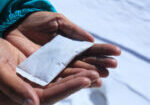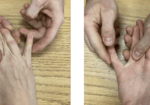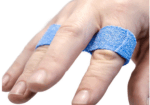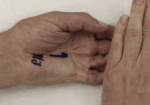Hand Therapy: Conservative Management of Pediatric Monteggia Fractures
Filed under Diagnoses
Conservative Management of Pediatric Monteggia Fractures
Monteggia fractures in children comprise approximately 2% of pediatric elbow fractures and involve a fracture of the proximal ulna with dislocation of the radial head (Fig. 1). The primary concern of Monteggia fractures includes the treatment (monteggia fracture treatment pediatric) and relocation of the radial head, because if left untreated it can lead to chronic elbow disability, progressive deformity, and loss of pronation/supination movement1.
Fig. 1. Pediatric Monteggia fracture showing a proximal ulnar shaft fracture and a proximal radial dislocation.
A study by Foran, et al., 2017 demonstrated that 83% of Monteggia fracture patients were successfully treated with conservative methods and did not require surgical intervention without compromising outcomes or increasing risk of complication. Typically, patients are immobilized either in a cast or custom thermoplastic long-arm orthotic for 4-6 weeks (Fig. 2).
Fig. 2. Custom thermoplastic long-arm/ Muenster orthotic to support forearm and block full elbow range of motion.
Patients are highly monitored throughout the first three weeks, as this is the time period when instability is most likely to occur. If there is adequate healing of the ulna between 4-6 weeks, the cast is removed and the patient transitioned to removable forearm orthotic, at which time, therapy is initiated1.
Special considerations to monitor for:
- Compartment syndrome
- Gradual decreasing range of motion:
- Tendon/nerve injuries
- Skin breakdown
- Risk of recurrent fractures up to 6-12 months
Therapeutic interventions:
- Mobility to wrist/forearm
- Range of motion to all joints involved in orthotic
- Ideas include: painting on vertical surface, playing cards, tossing magnetic darts, wrist maze, sport simulation (overhead tossing, dribbling, racket movements, etc.)
- Building endurance
- Grip/pinch/lift strengthening and weight bearing
- Ideas include: animal walks for weightbearing, wall push-ups against yoga ball,
- Desensitization
- Over fracture site or in fingertips after nerve injury
- Ideas include: sensation kit (small squares of various materials transitioning from smooth to rough: velvet/moleskin, foam, Velcro, netting, sandpaper, etc.)
- Neuromuscular ed-education
- Re-training of movement patterns for ADL’s that are compromised from fracture involvement
- Ideas include: tendon glides, nerve glides, NMES for muscle activation
- Orthotics to prevent joint contractures & promote functional positioning
- Orthotics to protect over fracture site and prevent re-fracture
- Dynamic orthotics to support muscles groups weakened by neuropraxia/ injury
1. Foran, I., Upasami, V.V., Wallace, C.D., Britt, E., Bastrom, T.P., Bomar, J.D., & Pennock, A.T. (2017). Acute pediatric monteggia fractures: A conservative approach to stabilization. Journal of Pediatric Orthopedics, 37(6), 335-341.
More To Read
How Weather Changes Affect Joint Pain
By: Lucas Godwin How Weather Changes Affect Joint Pain Numerous potential factors can cause weather-related joint pain, including humidity, temperature, precipitation, and changes in barometric pressure. Scientists have performed many studies on joint pain and weather over the years, but so far, none can say for sure what the connection is. Timmermans et al., 2015…
Read MoreHand Therapy Article Review: The Radial Synergy Test, An Aid to Diagnose de Quervain’s Tenosynovitis
Chihua, L., Langford, P.N., Sullivan, G.E., Langford, M.A., Hogan, C.J., & Ruland, R.T. (2021) The radial synergy test: an aid to diagnose de Quervain’s tenosynovitis. HAND. epub ahead of print;1-6. doi: 10.1177/15589447211057297 Rapid Review By: Case Peters The Skinny: de Quervain’s tenosynovitis is a common pathology that involves swelling and thickening of the tendon sheaths…
Read MoreA randomized clinical trial comparing early active motion programs: Earlier hand function, TAM, and orthotic satisfaction with a relative motion extension program for zones V and VI extensor tendon repairs
By Brittany Day Collocott SJ, Kelly E, Foster M, Myhr H, Wang A, Ellis RF. A randomized clinical trial comparing early active motion programs: Earlier hand function, TAM, and orthotic satisfaction with a relative motion extension program for zones V and VI extensor tendon repairs. Journal of Hand Therapy. 2019. doi:10.1016/j.jht.2018.10.003 The Skinny- This is…
Read MoreDiscovering Connections Between Trigger Finger and Dupuytren’s
Discovering Connections Between Trigger Finger and Dupuytren’s By: Tayer Roost Reference: Yang, Gehring, M., Bou Zein Eddine, S., & Hettinger, P. (2019). Association between stenosing tenosynovitis and dupuytren’s contracture in the hand. Plastic and reconstructive surgery. Global open, 7(1), e2088–e2088. https://doi.org/10.1097/GOX.0000000000002088 The Skinny: This retrospective chart review discussed the possibility of a correlation between stenosing…
Read MoreSign-up to Get Updates Straight to Your Inbox!
Sign up with us and we will send you regular blog posts on everything hand therapy, notices every time we upload new videos and tutorials, along with handout, protocols, and other useful information.






